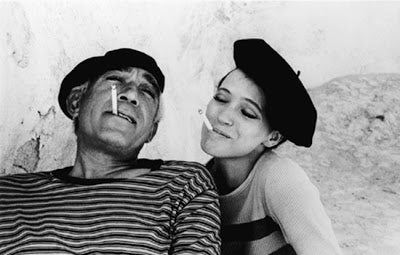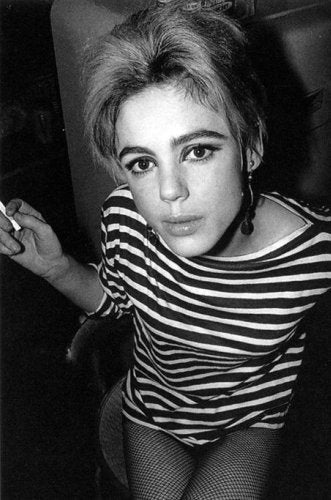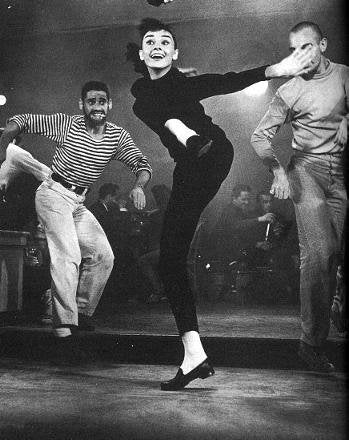Beatniks: The Beginnings of Casual Cool
Beatnik culture was, and is, still regarded as perhaps the beginnings of modern hipsterdom – an anti-materialistic, relaxed outlook on the world. With its beginnings in post-WWII America, the movement was home to Jack Kerouac and Allen Ginsberg, perhaps the most notorious “Beat” authors. But this was not only a literary statement; the Beatnik culture seeped into suburban culture and fashion. Surprisingly, the Beats established part of what we regard as “classic fashion” in modern day.
 Often interpreted as more of a media creation rather than a movement, Beat fashion became a means for youth to rebel against the traditions of their parental units and stiff dress codes. Men sported berets, beards, and turtlenecks, while feminine Beats favoured unstyled hair, leotards and leggings. With striped tops and slim cut dark trousers de rigueur for all genders, the style had a uniformity to it. Instead of fussing over perfectly coifed bouffants and greased back hair, Beatniks regarded themselves as perhaps more relaxed and worldly.
Often interpreted as more of a media creation rather than a movement, Beat fashion became a means for youth to rebel against the traditions of their parental units and stiff dress codes. Men sported berets, beards, and turtlenecks, while feminine Beats favoured unstyled hair, leotards and leggings. With striped tops and slim cut dark trousers de rigueur for all genders, the style had a uniformity to it. Instead of fussing over perfectly coifed bouffants and greased back hair, Beatniks regarded themselves as perhaps more relaxed and worldly.
 Uninterested, untethered, and unconventional, the anti-materialistic Beats were cooly aloof. Their interests ran the gamut of introspective poetry, jazz, non-Western religion; they were open to marijuana usage and other free-wheeling activities. In short, they rebelled against the societal expectations of the time, practicing free-thinking, bohemian lives. Regardless, they remained a mainstay in the American psyche throughout the 1950s and 60s.
Uninterested, untethered, and unconventional, the anti-materialistic Beats were cooly aloof. Their interests ran the gamut of introspective poetry, jazz, non-Western religion; they were open to marijuana usage and other free-wheeling activities. In short, they rebelled against the societal expectations of the time, practicing free-thinking, bohemian lives. Regardless, they remained a mainstay in the American psyche throughout the 1950s and 60s.
Every great fashion moment needs a poster girl, and two come to mind for this particular time. Both Edie Sedgwick of Warholian Factory fame and Audrey Hepburn in Funny Face come to mind. Both represented looks that are referenced, reframed and reinterpreted to this day, more than 50 years after their genesis.
 Edie Sedgwick was a wisp of a gal, rising to fame as a bubbly New York socialite (rumour has it she had a dalliance with Bob Dylan). She befriended Andy Warhol at the height of his popularity, and went on to solidify her status in fashion history as a standout representation of the Beatnik life. Often found in leotards and leggings, Edie quickly gained notoriety for her fun-loving, free-spirited and impeccably daring style. Although she suffered an untimely and early death, one might say Edie was the ultimate Beat girl.
Edie Sedgwick was a wisp of a gal, rising to fame as a bubbly New York socialite (rumour has it she had a dalliance with Bob Dylan). She befriended Andy Warhol at the height of his popularity, and went on to solidify her status in fashion history as a standout representation of the Beatnik life. Often found in leotards and leggings, Edie quickly gained notoriety for her fun-loving, free-spirited and impeccably daring style. Although she suffered an untimely and early death, one might say Edie was the ultimate Beat girl.
Audrey’s contribution to lasting Beat influence was less of a lifestyle choice and more of a calculated publicity move. Her 1957 film Funny Face featured costuming by Academy Award winning costume designer Edith Head and critically acclaimed couturier Hubert Givenchy. An iconic visual representation of Beat culture; simple, chic and pared down outfits are seen throughout. The film still serves as reference point today; a dance sequence was notably recreated in the music video for Countdown by Beyonce.

Although it was, perhaps, a flash-in-the-pan as far as cultural movements go, Beatniks have maintained a stronghold on what we perceive as a modern, classic style. Striped bretons and black loafers are as relevant today as they were to chic Chelsea girls in the 1950s. The intellectualism, philosophy and counter culture of the Beats may have fallen to the wayside, but we can thank them for giving us an easy-going style that continues to remain current!
–Lydia Okello
